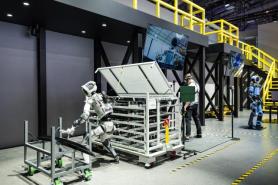
SEOUL -- The world's third-largest carmaker Hyundai Motor has partnered with the western port city of Incheon in a bid to accelerate the commercialization of urban air mobility services, also known as flying taxi services, using manned and unmanned passenger drones.
Urban air mobility (UAM) is infrastructure for commercial flying passenger vehicles that includes vertiports and control towers. Aerial vehicles are required to fly through designated aerial corridors to prevent accidents and improve the safety of pedestrians on the land. Vertiports will be placed on safe places like rooftops.
"K-UAM One Team" is a consortium of five companies including Hyundai Motor, telecom operator KT, flag carrier Korean Air, the Incheon International Airport Corporation, and constructor Hyundai E&C. South Korea aims to commercialize manned drone taxis in 2025. Remote-controlled vehicles will be adopted in 2030 and a fully autonomous service in 2035. A safety manager will board each flying vehicle until pilots are no longer needed.
Hyundai Motor said that the K-UAM One Team signed a cooperation agreement with Incheon City to establish a foundation for the development of a UAM network that connects Incheon, Seoul, and Gyeonggi Province that surrounds Seoul and its satellite cities. Hyundai said that islets scattered west of Incheon can be used as testing grounds for flying taxis.
In October, Hyundai Wia, a parts-making wing of Hyundai auto group, signed a memorandum of understanding with Supernal, an independent urban air mobility company set up by Hyundai's United States office, to develop and manufacture UAM's landing systems by 2028.
The parts maker said the company plans to receive airworthiness certification from the U.S. Federal Aviation Administration (FAA) for the to-be-developed "wheel-type landing system" for flying urban vehicles.
A standard certificate of airworthiness (CoA) issued by the FAA is a permit for commercial passenger or cargo operation of an aircraft. More than 1,300 engineers, scientists, inspectors, test pilots, and other experts are involved in the certification process to check and analyze the design, production, and airworthiness of aircraft.
The landing system for UAMs to be developed by Hyundai Wia and Supernal will have a "health monitoring" feature that will allow operators and managers to monitor and diagnose the integral structure of vertiports, which are vertical landing pads, to reduce maintenance costs and prevent safety accidents.
Hyundai Wia said the company will utilize its aircraft construction know-how to develop the next-generation vertiports. The parts maker provides landing systems for T-50, South Korea's homemade supersonic trainer jet, and homemade military light attack helicopters.
Copyright ⓒ Aju Press All rights reserved.




